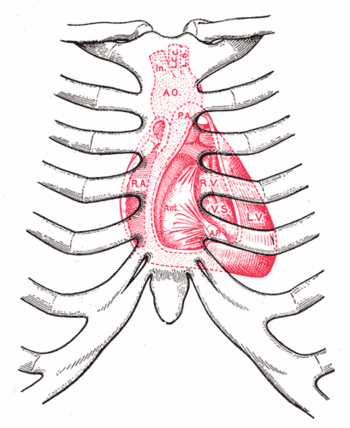Heart sound: Difference between revisions
imported>Robert Badgett (New page: {{subpages}} In medicine, heart sounds are the "sounds heard over the cardiac region produced by the functioning of the heart. There are four distinct sounds: the first occurs at the begin...) |
imported>Robert Badgett No edit summary |
||
| Line 1: | Line 1: | ||
{{subpages}} | {{subpages}} | ||
In medicine, heart sounds are the "sounds heard over the cardiac region produced by the functioning of the heart. There are four distinct sounds: the first occurs at the beginning of systole and is heard as a "lubb" sound; the second is produced by the closing of the aortic valve and pulmonary valve and is heard as a "dupp" sound; the third is produced by vibrations of the ventricular walls when suddenly distended by the rush of blood from the heart atria; and the fourth is produced by atrial contraction and ventricular filling."<ref>{{MeSH}}</ref> | In [[medicine]], '''heart sounds''' are the "sounds heard over the cardiac region produced by the functioning of the heart. There are four distinct sounds: the first occurs at the beginning of systole and is heard as a "lubb" sound; the second is produced by the closing of the aortic valve and pulmonary valve and is heard as a "dupp" sound; the third is produced by vibrations of the ventricular walls when suddenly distended by the rush of blood from the heart atria; and the fourth is produced by atrial contraction and ventricular filling."<ref>{{MeSH}}</ref> | ||
==Normal heart sounds== | |||
[[Image:Gray-image1218.gif|right|thumb|350px|{{#ifexist:Template:Gray-image1218.gif/credit|{{Gray-image1218.gif/credit}}<br/>|}}The location of the heart below the thoracic wall.]] | |||
===S<sub>1</sub>=== | |||
S<sub>1</sub>, which originates from closure of the mitral and tricuspid valves is normally louder than S<sub>2</sub> at the cardiac apex (fifth left intercostal space).<ref name="isbn1-4160-2898-6_p418">{{cite book |author=McGee, Steven R. |authorlink= |editor= |others= |title=Evidence-Based Physical Diagnosis: Text with BONUS PocketConsult Handheld Software |edition= |language= |publisher=Saunders |location=Philadelphia |year=2007 |origyear= |pages=418 |quote= |isbn=1-4160-2898-6 |oclc= |doi= |url= |accessdate=}}</ref> | |||
===S<sub>2</sub>=== | |||
S<sub>2</sub> is normally louder than S<sub>1</sub> at the cardiac base (second left intercostal space).<ref name="isbn1-4160-2898-6_p415">{{cite book |author=McGee, Steven R. |authorlink= |editor= |others= |title=Evidence-Based Physical Diagnosis: Text with BONUS PocketConsult Handheld Software |edition= |language= |publisher=Saunders |location=Philadelphia |year=2007 |origyear= |pages=415 |quote= |isbn=1-4160-2898-6 |oclc= |doi= |url= |accessdate=}}</ref> | |||
The S<sub>2</sub> is composed of A<sub>2</sub> and P<sub>2</sub>: | |||
* A<sub>2</sub> originates from closure of the aortic valve | |||
* P<sub>2</sub> originates from closure of the pulmonic valve, is best heard at the cardiac base (second left intercostal space), and is quieter than A<sub>2</sub>. | |||
** During expiration, A<sub>2</sub> and P<sub>2</sub> are perceived as a single sound in 90% of people.<ref name="isbn1-4160-2898-6_p422">{{cite book |author=McGee, Steven R. |authorlink= |editor= |others= |title=Evidence-Based Physical Diagnosis: Text with BONUS PocketConsult Handheld Software |edition= |language= |publisher=Saunders |location=Philadelphia |year=2007 |origyear= |pages=422 |quote= |isbn=1-4160-2898-6 |oclc= |doi= |url= |accessdate=}}</ref><ref name="pmid5718983">{{cite journal |author=Harris A, Sutton G |title=Second heart sound in normal subjects |journal=British heart journal |volume=30 |issue=6 |pages=739–42 |year=1968 |month=November |pmid=5718983 |pmc=487796 |doi= |url=http://heart.bmj.com/cgi/pmidlookup?view=long&pmid=5718983 |issn=}} [http://www.pubmedcentral.nih.gov/articlerender.fcgi?tool=citizendium&pubmedid=5718983 PubMed Central]</ref> | |||
** During inspiration, the interval between A<sub>2</sub> and P<sub>2</sub> lengthens ('splits') and may as long as 60 msecs.<ref name="pmid5718983"/> | |||
==References== | ==References== | ||
<references/> | <references/> | ||
==Bibliography== | |||
* {{cite book |author=McGee, Steven R. |authorlink= |editor= |others= |title=Evidence-Based Physical Diagnosis: Text with BONUS PocketConsult Handheld Software |edition= |language= |publisher=Saunders |location=Philadelphia |year=2007 |origyear= |pages= |quote= |isbn=1-4160-2898-6 |oclc= |doi= |url= |accessdate=}} | |||
* {{cite book |author=Drummond Rennie; David Simel |authorlink= |editor= |others= |title=THE RATIONAL CLINICAL EXAMINATION: EVIDENCE-BASED CLINICAL DIAGNOSIS (Jama & Archives Journals) |edition= |language= |publisher=McGraw-Hill Professional |location= |year=2008 |origyear= |pages= |quote= |isbn=0-07-159030-7 |oclc= |doi= |url= |accessdate=}} | |||
==See also== | |||
* [[Heart murmur]] | |||
Revision as of 01:16, 4 November 2008
In medicine, heart sounds are the "sounds heard over the cardiac region produced by the functioning of the heart. There are four distinct sounds: the first occurs at the beginning of systole and is heard as a "lubb" sound; the second is produced by the closing of the aortic valve and pulmonary valve and is heard as a "dupp" sound; the third is produced by vibrations of the ventricular walls when suddenly distended by the rush of blood from the heart atria; and the fourth is produced by atrial contraction and ventricular filling."[1]
Normal heart sounds
S1
S1, which originates from closure of the mitral and tricuspid valves is normally louder than S2 at the cardiac apex (fifth left intercostal space).[2]
S2
S2 is normally louder than S1 at the cardiac base (second left intercostal space).[3]
The S2 is composed of A2 and P2:
- A2 originates from closure of the aortic valve
- P2 originates from closure of the pulmonic valve, is best heard at the cardiac base (second left intercostal space), and is quieter than A2.
References
- ↑ Anonymous (2024), Heart sound (English). Medical Subject Headings. U.S. National Library of Medicine.
- ↑ McGee, Steven R. (2007). Evidence-Based Physical Diagnosis: Text with BONUS PocketConsult Handheld Software. Philadelphia: Saunders, 418. ISBN 1-4160-2898-6.
- ↑ McGee, Steven R. (2007). Evidence-Based Physical Diagnosis: Text with BONUS PocketConsult Handheld Software. Philadelphia: Saunders, 415. ISBN 1-4160-2898-6.
- ↑ McGee, Steven R. (2007). Evidence-Based Physical Diagnosis: Text with BONUS PocketConsult Handheld Software. Philadelphia: Saunders, 422. ISBN 1-4160-2898-6.
- ↑ 5.0 5.1 Harris A, Sutton G (November 1968). "Second heart sound in normal subjects". British heart journal 30 (6): 739–42. PMID 5718983. PMC 487796. [e] PubMed Central
Bibliography
- McGee, Steven R. (2007). Evidence-Based Physical Diagnosis: Text with BONUS PocketConsult Handheld Software. Philadelphia: Saunders. ISBN 1-4160-2898-6.
- Drummond Rennie; David Simel (2008). THE RATIONAL CLINICAL EXAMINATION: EVIDENCE-BASED CLINICAL DIAGNOSIS (Jama & Archives Journals). McGraw-Hill Professional. ISBN 0-07-159030-7.
